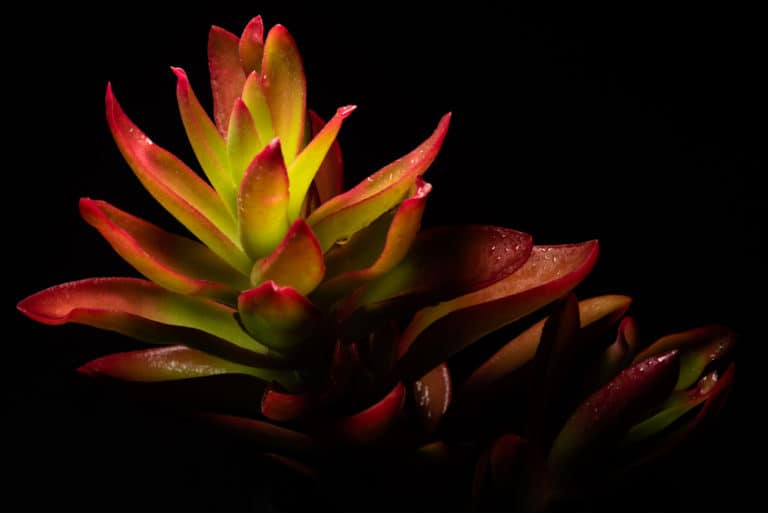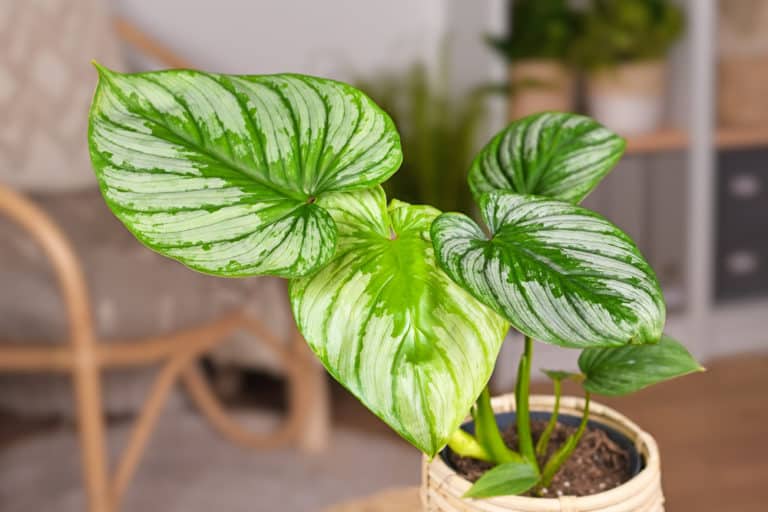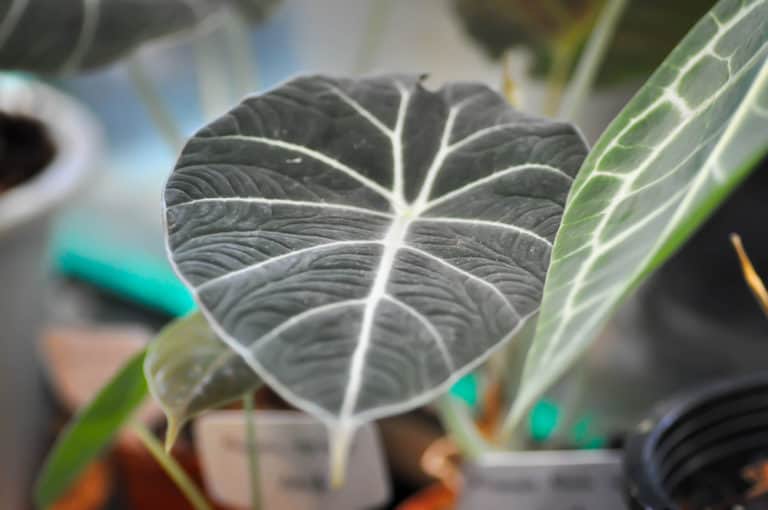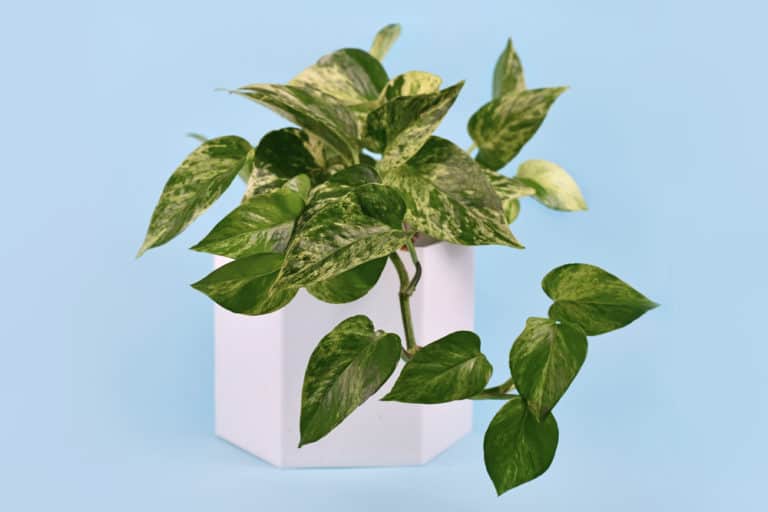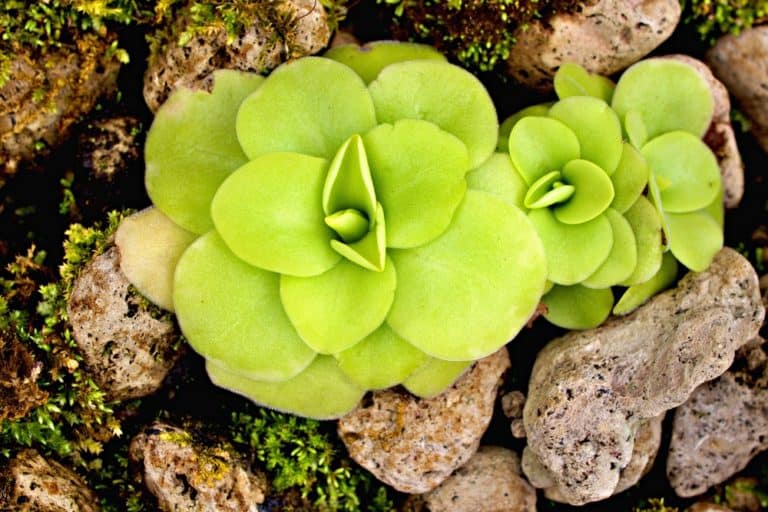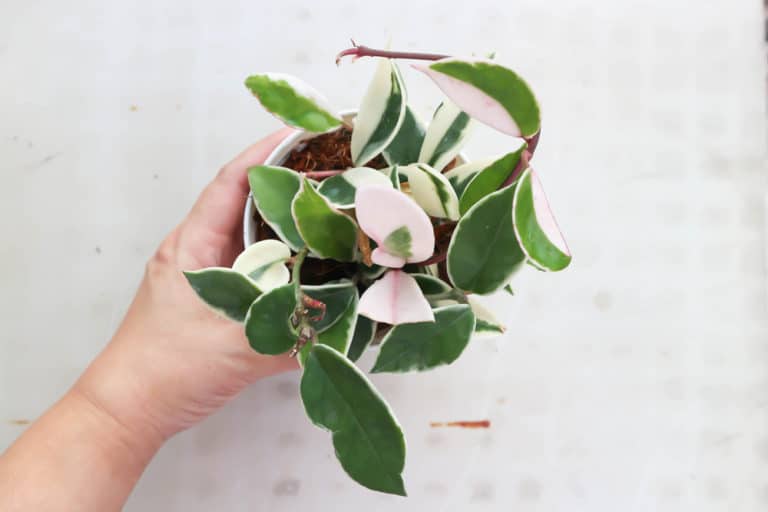Peperomia Obtusifolia ‘Baby Rubber Plant’ Care Guide (2024)
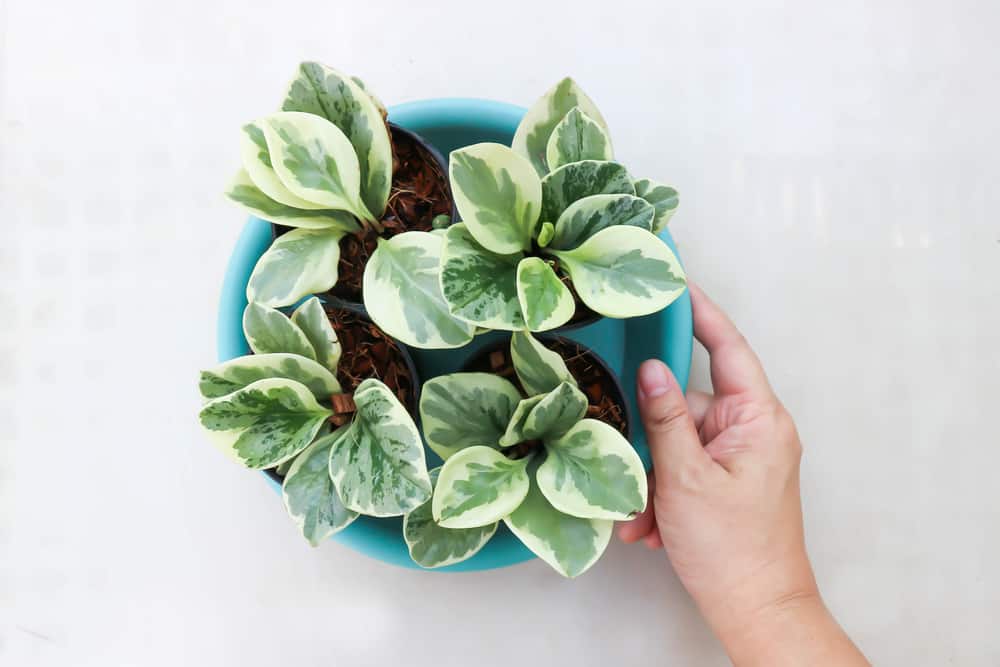
Peperomia obtusifolia is a cute little houseplant that is a great addition to your indoor garden, whether you’re a beginner or expert.
The baby rubber plant is an easy-going evergreen tropical plant that will happily adapt to standard indoor conditions.
Its compact growth habit makes it a great choice for small spaces.
| Scientific Name | Peperomia obtusifolia |
| Common Name | Baby Rubber Plant, Pepper Face Plant |
| Light | Bright indirect sunlight |
| Watering | Water if the top half of the soil is dry |
| Temperature | 65 to 75ºF (18 to 24ºC) |
| Hardiness Zone | 10 to 12 |
| Humidity | 50% |
| Soil Type | Rich, quick-draining, loamy |
| Soil pH | 6 to 6.6 (mildly acidic) |
| Fertilizing | A balanced feed once a month in spring and summer |
| Repotting | Every 5 years |
| Pruning | Spring and summer |
| Propagation | Leaf or stem tip cuttings |
| Toxicity | Not toxic to humans and pets |
| Mature Size | 6 to 12 inches as a houseplant |
| Bloom Time | Spring to fall |
What’s Unique About Peperomia obtusifolia?
The Peperomia obtusifolia plant is native to a broad band across the tropics and subtropics of the Americas, from South Florida to Brazil, and everywhere in between.
While it’s called the baby rubber plant, it’s not actually related to the rubber tree.
Peperomia obtusifolia plants are a popular choice for homes and public spaces because of their attractive evergreen leaves and compact size.
Growing Peperomia obtusifolia is easy, once you’ve mastered a few key requirements.
The baby rubber plant is also useful as well as decorative; the foliage is effective at filtering out contaminants such as formaldehyde from indoor environments.
Peperomia obtusifolia Care
In the tropical and subtropical rainforests where the baby rubber plant originates, it grows on the forest floor, scrambling over dead logs as it climbs.
In your home, you can provide excellent Peperomia obtusifolia plant care by paying attention to the conditions in which it thrives.
Your baby rubber plant care should focus on bright, indirect light, warm temperatures, and moderate to high humidity.
Light
In its native rainforests, the baby rubber plant grows under the shade of the tree canopy, which filters the hot rays of the sun.
Thus, Peperomia obtusifolia light requirements are for bright but indirect light, or between 10,000 to 20,000 lux.
These baby rubber plant light needs are best met in an east-facing window which will not get the full sun in the afternoon.
If all you have is a south or west exposure, find a spot in the room where the direct sun does not reach.
Extended exposure to the full sun will burn the delicate leaves of your Peperomia obtusifolia.
In a windowless office, you should be okay with an overhead fluorescent light for 8 or more hours a day.
Watering
Peperomia obtusifolia has evolved to withstand periods without water, as its semi-succulent leaves retain water.
Do not keep your Peperomia obtusifolia watering to a strict schedule, but rather water baby rubber plant as needed.
Its watering needs will change with the seasons. While it may need water once a week in summer, it may take 2 to 3 times as long in winter for the soil to dry out.
Check the soil moisture regularly, and when the top half of the soil has dried out, soak the pot thoroughly to top it up.
Always let excess water drain out before setting your Peperomia obtusifolia pot back in its saucer.
Temperature
The ideal Peperomia obtusifolia temperature range is between 65 to 75ºF (18 to 24ºC).
Basically, any temperature that you are comfortable in is a good temperature for baby rubber plant.
You can move your Peperomia obtusifolia outdoors for the summer in temperate zones, where the high heat and humidity can encourage healthy growth.
Just be sure to move it back in long before winter, as it has a limited temperature tolerance below 50ºF (10ºC).
Also, make sure you keep it out of drafts and away from cold windows indoors in winter.
Peperomia obtusifolia has no frost hardiness, and freezing temperatures will kill it.
Humidity
Peperomia obtusifolia humidity requirements are pretty reasonable.
While the ideal humidity for baby rubber plant is very high, as would be expected for a rainforest native, it will grow quite happily around 40 to 50% humidity.
To give your Peperomia obtusifolia a real treat, you can keep it in your bathroom where it will get a warm, steamy environment with every bath or shower.
Alternatively, you can mist the leaves every few days, or place it atop a pebble tray filled with water.
The best solution for all your humidity-loving tropical plants is to invest in a small humidifier to place in their midst.
Soil
In their native habitat in the rainforests, Peperomia obtusifolia grows in spongy soil filled with organic matter. It drains well but retains moisture.
Peperomia obtusifolia soil needs to replicate those basic conditions.
The best pH level for baby rubber plant is 6 to 6.6, or mildly acidic.
While you can make your own soil for baby rubber plant, it’s also perfectly fine to use a commercial African Violet soil mix. The two plant families have very similar needs.
You can also simply combine equal parts of peat moss and perlite for a good Peperomia obtusifolia soil. Throw in a handful of compost for extra nutrients.
Fertilizer
You don’t need to use a lot of Peperomia obtusifolia fertilizer, but regular light feedings will aid strong growth of the leaves.
The easiest fertilizer for baby rubber plant is organic matter such as well-rotted compost or worm castings. Work it into the top layer of the soil.
You can do this at the beginning of the growing season, and then every couple of months until the fall.
However, a standard liquid houseplant fertilizer with a 20-20-20 fertilizer ratio will work well, too.
Dilute it to half strength and pour it evenly over the soil surface shortly after you’ve watered your Peperomia obtusifolia.
Potting & Repotting
Peperomia obtusifolia repotting does not have to be done very often. You may only find yourself repotting baby rubber plant every five years or so.
Just keep an eye on your Peperomia obtusifolia’s pot. When you see roots growing out of the drainage holes, or filling up the pot, it’s time to move it up.
Only go up one pot size when you do repot, as too much empty soil can set back your Peperomia obtusifolia’s growth.
Use a pot with good drainage holes.
Finally, whenever you repot your Peperomia obtusifolia, always use fresh potting soil to discourage the development of disease.
Pruning
While you don’t need to do much Peperomia obtusifolia pruning, pinching back stem tips can encourage bushier growth for a more attractive look.
It’s best to undertake any pruning in the spring and summer while the plant is actively growing.
When cutting baby rubber plant, use sharp, sterilized scissors, and make clean cuts.
Save any stems and leaves for propagation.
Cut right above a node, as this will encourage new growth to branch off from there.
Even if you’re not interested in pruning to shape your Peperomia obtusifolia, you should always be ready to trim off any dead or damaged growth.
Propagation
The easiest ways to propagate baby rubber plant are with stem or leaf cuttings.
For Peperomia obtusifolia propagation using stem cuttings, simply take lengths of stem with at least 2 nodes and a few leaves. Cut right below the lowest node, and strip off all but the top leaves.
Put the cuttings in a jar of water, and place it in a warm spot out of the direct sun. Change the water every few days.
Leaf cuttings are just as easy to work with. Cut a leaf off with just a stub of the petiole, and place the cut end down in moist soil. Cover it with a plastic bag, and leave it in a warm location.
Both methods should produce healthy rooted cuttings in a month or so.
Also, make sure to check out our in-depth Peperomia rosso plant care guide.
Common Problems of Peperomia obtusifolia
Most Peperomia obtusifolia problems are caused by poor growing conditions, so the best way to prevent problems with baby rubber plant is to give it what it needs for healthy growth.
However, if you see drooping or discolored leaves, get right to work to find out what is wrong with your Peperomia obtusifolia.
Pests
There are relatively few Peperomia obtusifolia pests, and you can prevent even them from showing up with one easy trick.
Once a month, either spray or wipe the leaves of your baby rubber plant with an insecticidal soap or neem oil solution, which should deter any bugs.
Spider mites are the most likely insects to find on your Peperomia obtusifolia.
You might not even be able to see the little critters, but you will see the yellow bumps and sticky webs they leave behind.
Simply take your Peperomia obtusifolia over to the sink and give all the foliage a thorough rinsing.
Mealybugs are ubiquitous on houseplants. Their cottony tufts turn up on the underside of leaves.. Wipe them away with rubbing alcohol.
Diseases
You can usually stave off the development of any Peperomia obtusifolia diseases by practicing good watering methods.
Never water your baby rubber plant so much that its roots are sitting in soaking wet soil, and avoid getting the leaves wet.
Root rot is a common problem when soil is kept too wet. It leads to yellowing leaves and rotting stems, and of course rotten, black roots. Cut off the rotten bits and repot the plant in fresh soil.
Botrytis is a fungal condition that spreads a gray mold across the leaves. Use a copper fungicide to kill it.
Peperomia ringspot shows up as brown circles on the leaves. Remove all infected foliage and spray the underside of the leaves with neem oil.
Growing Problems
Other growing problems can be resolved as easily as moving your sick plant from one location to another.
Leaves falling off is usually a sign that your Peperomia obtusifolia has been subjected to sudden changes in temperature. Make sure that it’s not sitting in a draft or too close to a heat source.
Brown leaf tips indicate that your Peperomia obtusifolia is too cold. Again, watch out for drafts and keep the plant away from cold windows in winter.
Shriveling leaves often mean a build-up of fertilizer salts in the soil. Flush them out by running a gentle stream of water through the soil for about 10 minutes.
Toxicity of Peperomia obtusifolia
The baby rubber plant is not toxic to humans or animals.
Because of its lack of toxicity, you can add it to your indoor garden without worrying about disruptive and expensive visits to the hospital or veterinarian’s office.
That being said, it’s never a good idea to give your children or pets untrammeled access to your houseplants.
For Humans
Peperomia obtusifolia is not at all toxic to humans. You can work with your baby rubber plant without taking any special precautions.
However, while children are not in danger of a life-threatening response to ingesting the foliage, they may still be at some risk.
The insecticides, fungicides, and fertilizers that you may be using are not safe for children, even if they are organic.
As well, children are not going to be able to tell the difference between plants that are safe and those that aren’t.
It’s best just to teach your children from an early age that they are not to touch the plants.
For Pets
Peperomia obtusifolia is not toxic to pets, but you still don’t want your cat and dog eating your baby rubber plant.
Obviously, it’s not good for your plant. It wouldn’t take long for a determined cat to destroy your Peperomia obtusifolia.
However, it’s also not good for your pets.
While the Peperomia obtusifolia does not contain any poisonous substances, it’s still a plant.
Carnivores like cats and dogs are not equipped with a digestive system that can handle large amounts of plant material.
The result of eating too many Peperomia obtusifolia leaves will be a bout of vomiting and diarrhea.
Peperomia obtusifolia Appearance
The classic, simple green leaves of this tropical beauty make the Peperomia obtusifolia appearance hard to beat.
However, you do have an option: the Peperomia obtusifolia ‘Variegata’ features leaves splashed in shades of green, olive green, and cream.
There’s nothing wrong with the original model, though, as it has a compact form that will fit in anywhere.
Foliage
The foliage of Peperomia obtusifolia has a simple, elegant form.
The leaves alternate their way up the thick, fleshy stems, growing out on short petioles.
Each leaf is 2 to 4 inches long and forms a simple spoon shape, curling up slightly towards the center rib. The margin is smooth with no indentations.
Leaves are a bright medium green, and are thick and leathery with a waxy, glossy surface. They are evergreen and will last for a long time before dying.
It’s a good idea to wipe them down once a month to keep them looking their best and photosynthesizing efficiently.
Flowering
While Peperomia obtusifolia flowering is not unusual, even on indoor plants, it’s also not necessarily desirable.
The baby rubber plant flower is not particularly attractive. In fact, they are often referred to as rat tails, because that’s what Peperomia obtusifolia flowers look like.
When your Peperomia obtusifolia is blooming, you will see 5 inch spikes covered in tiny white flowers sticking up above the leaves.
They can bloom multiple times through the growing season, but many gardeners actually cut them off so that the plant can use that energy on growing leaves instead.
The Peperomia obtusifolia flowers have no fragrance.
Size and Growth
The compact size of Peperomia obtusifolia is one of its real attractions, especially for apartment dwellers without a lot of room to spare.
Peperomia obtusifolia has a slow growth rate and can take a few years to reach its full size of 12 inches with a spread of 12 to 24 inches.
It can grow into a dense, bushy form. You may need to give it some support as it grows, or you can plant it in a hanging planter and let its stems trail downwards.
It’s best to rotate its pot a quarter turn a week to make sure it doesn’t develop a lean towards the strongest light.
Peperomia obtusifolia Fragrance
There is no Peperomia obtusifolia fragrance. The evergreen foliage has no scent, and neither do the seasonal flowers, as they do not depend on attracting insects for pollination.
However, Peperomia obtusifolia does a good job clearing the air of undesirable substances such as formaldehyde from the air.
Additionally, there are many circumstances under which it’s better not to have a heavily-scented plant around.
You may not want an overwhelming fragrance in a small space like a studio apartment.
As well, many public places like malls and hotels prefer to use unscented plants so as not to trigger allergic reactions in guests.
Suggested Uses for Peperomia obtusifolia
As an indoors houseplant, Peperomia obtusifolia gives you a lot of options for using it in your decor.
Because of its compact size, you can tuck this plant almost anywhere that suits its requirements for healthy growth.
Keep one on your bathroom counter where it will love the extra humidity, or hang one from your bedroom ceiling to clean the air as you sleep.
One of the most fun ways you could use Peperomia obtusifolia is as a component of a living wall installation, where various plants are used to create a living tapestry.
Outdoors, you can plant a grouping of Peperomia obtusifolia plants to create a ground cover.
FAQ
What is Peperomia obtusifolia?
Peperomia obtusifolia, also called baby rubber plant, is an evergreen tropical plant native to rainforests from south Florida to Brazil. It is grown as a houseplant.
How to identify Peperomia obtusifolia?
Peperomia obtusifolia has thick, leathery spoon-shaped leaves that grow on compact, bushy plants. The leaves are a medium green and have a waxy, glossy texture.
How to care for Peperomia obtusifolia?
Peperomia obtusifolia should be grown in bright but indirect light in well-draining soil with high organic content. Keep it in a warm spot with moderate to high humidity.
How to grow Peperomia obtusifolia indoors?
Peperomia obtusifolia can be grown indoors in a space with a temperature between 65 to 75ºF (18 to 24ºC), in a location out of the full sun.
How to grow Peperomia obtusifolia outdoors?
Peperomia obtusifolia can be grown outdoors year-round in zones 10 to 12, or can be taken outdoors in the hot summer months in temperate regions.
How fast does Peperomia obtusifolia grow?
Peperomia obtusifolia has a moderately slow growth rate, taking several years to reach its full size of only a foot tall when grown indoors as a potted plant.
How tall does Peperomia obtusifolia grow?
Peperomia obtusifolia grows to a full size of 12 inches tall with a spread from 12 to 24 inches, depending on how much it is trimmed.
How to make Peperomia obtusifolia grow faster?
Peperomia obtusifolia will grow its fastest when kept in an extremely warm and humid environment with bright but indirect light, with regular light watering and moderate fertilization.
How to stake Peperomia obtusifolia?
Peperomia obtusifolia can be staked with a short bamboo stick to help keep it growing upright. You can also let the stems trail down from a hanging basket.
How to pot Peperomia obtusifolia?
Peperomia obtusifolia should be repotted every 5 years in a porous soil mix with lots of organic matter, in a pot that has good drainage holes.
How to revive Peperomia obtusifolia?
If your Peperomia obtusifolia has started to droop and shrivel, it needs a good watering. Soak the pot until the soil is saturated, and then let it drain thoroughly.
Why is my Peperomia obtusifolia dying?
Your Peperomia obtusifolia may have a fungal disease called root rot. Cut off all affected parts and repot what’s left in fresh soil in a disinfected pot.
Why is my Peperomia obtusifolia drooping?
Your Peperomia obtusifolia may be getting too much water, or not enough. Check the soil moisture and proceed accordingly by either soaking the pot or replacing the wet soil.
How cold can Peperomia obtusifolia tolerate?
Peperomia obtusifolia will grow well at temperatures as low as 65ºF (18ºC). However, it will start to drop leaves and its growth will stall below 50ºF (10ºC), and freezing temperatures will kill it.
How to get rid of pests on Peperomia obtusifolia?
Peperomia obtusifolia pests can be prevented if it is regularly sprayed with water in the sink, or by wiping the leaves with an insecticidal soap or neem oil solution.
Is Peperomia obtusifolia toxic to cats?
No, Peperomia obtusifolia is not toxic to cats. However, they have difficulty digesting plant material and will have vomiting and diarrhea if they eat too much.
Is Peperomia obtusifolia toxic to dogs?
No, Peperomia obtusifolia is not toxic to dogs, but as they are carnivores, their systems are not equipped to process much vegetative matter, leading to gastrointestinal distress.
Is Peperomia obtusifolia toxic to children?
No, Peperomia obtusifolia is not toxic to children. However, the insecticides and fertilizers that you use on your houseplants should not be ingested by humans.
Is Peperomia obtusifolia toxic to humans?
No, Peperomia obtusifolia is not toxic to humans at all. This means that you can handle the plant without taking any precautions to protect yourself.
Does Peperomia obtusifolia have a scent?
Neither the Peperomia obtusifolia foliage nor the flowers have any fragrance, so this plant is ideal for many public settings where fragrant plants are discouraged.

